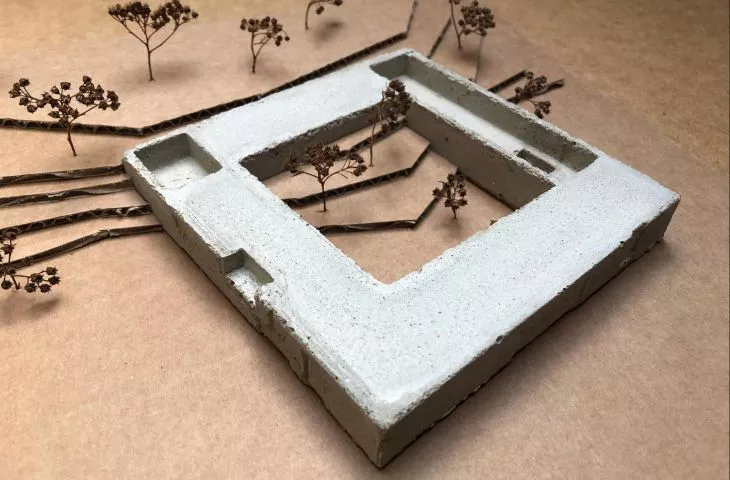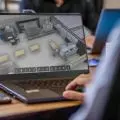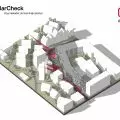The projected facility was deliberately located in the former Odra I limestone pit in Opole. This heavily transformed area perfectly illustrates how man affects the natural environment and how nature copes with these changes.
The square object symbolically unites the surrounding areas. The first is the active Odra II mine - symbolizing the exploitation of nature; the next is the Odra Opole cement plant - symbolizing the processing of raw materials; the city - the result of man's work and his refuge; and the Odra I stonework - an image of nature reborn.
diagram
© Matthew Mikolajow
patio
Inside the establishment there is a large patio. It is an attempt to incorporate the natural environment into the functioning of the facility. Its central location has a beneficial effect on the microclimate, lowering the temperature and regulating humidity. The patio is also part of the exhibition, plant species that can be cultivated on post-mining areas are shown here.
patio - the green heart of the building
© Mateusz Mikolajow
materials
The context is also evident in the materials used in the project. Concrete - long manufactured in Opole - was used as the main material. Back in 1968, there were four cement factories operating on the site. Today, one operates - the Odra Opole cement plant adjacent to the development site. The complementary material is limestone - also a material characteristic of Opole's architecture.
function
The designed facility is functionally divided into three parts: an exhibition - to educate about climate change and human impact on it, a workshop and conference part - to search for ways to stop climate change, and a research part, where these solutions are implemented.
diagram
© Matthew Mikolajow
exhibition
The exhibition has been implemented in the form of augmented reality rooms. This allows the content of the exhibition to be easily modified. It is also an attractive way of presentation for young visitors. As we walk through the rooms, we learn about different worlds:
-
Nature without man - a picture of a world where human interference is limited;
-
Nature with man - a picture of a world devastated by man;
-
In the next room there is a pot in which a tree grows on a higher floor. Through the walls of the pot, the tree's roots and soil are visible. This symbolizes the need to reflect, to return to the roots, to nature. It can also be read as the need to go underground if the outside conditions deteriorate drastically;
-
The next room is a vision of the future world based on the coexistence of man and nature. There is also an opportunity here to present student projects of future cities - as possible scenarios;
-
The last element of the exhibition is the entrance to the energy garden located on the floor above. It contains unconventional devices for generating electricity. It ends with a tree - symbolizing the natural transformation of energy in nature.
views
A very important element of the project is the view from the windows, which becomes part of the display. The scene seen in the visualization depicts the still-operating Odra cement plant towering over the pit, which is juxtaposed with the stonework's reviving natural environment.
visualization: the lump and the view from the windows, which is part of the exhibition
© Mateusz Mikolajow
summary
The project addresses an important issue related to ongoing climate change and the responsibility that people have. It does so in three areas: educational (through the exhibition), promotional (through conducting workshops) and research (through research in laboratories). It is a place that teaches, a place where new ideas are born and where these ideas are implemented.
Matthew MIKOLAJÓW
© Author
































































